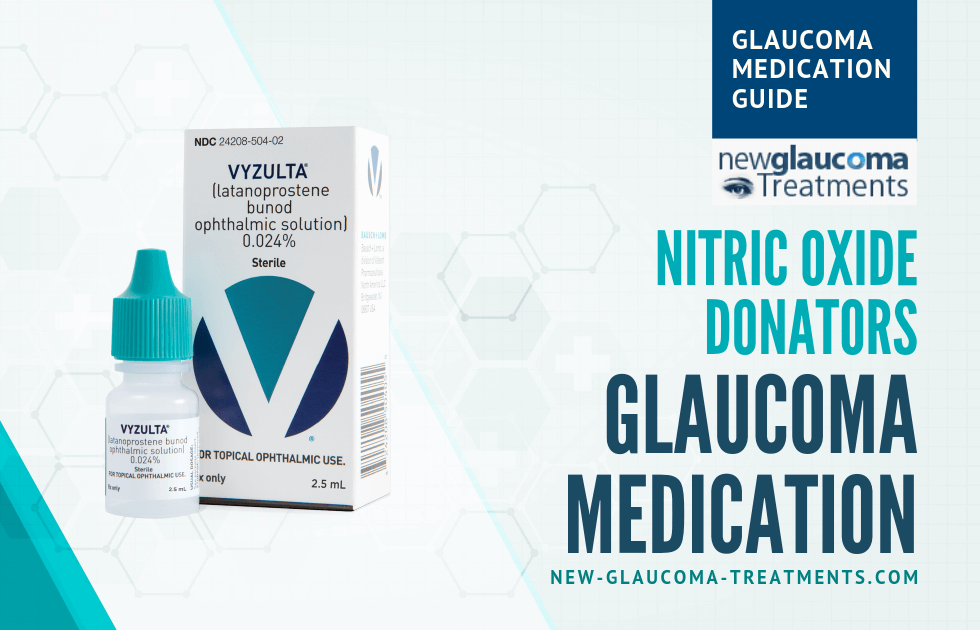A Patient’s Guide to Glaucoma Medications

Nitric Oxide Donators Medication for Glaucoma
Commonly prescribed:
As of early 2019 Latanoprostene bunod 0.024% (Brand name: VyzultaTM) is the only FDA approved medication in this class. Approved in November, 2017, this medication is best considered to be a modified prostaglandin (or as I like to tell my patients, “a prostaglandin-plus”) as it includes the mechanisms of action and benefits of both the prostaglandin analog class and nitric oxide donating class. Currently, there are no FDA approved medications that work solely by donating a nitric oxide molecule.
Cap color:
Teal (same as prostaglandin analog class)
How it is taken:
One eye drop every evening.
How it works:
Trabecular Meshwork Activity
Nitric oxide works by “relaxing” the trabecular meshwork as well as the canal of Schlemm (the drainage system that encircles the front of the eye)[1]. As such, it is one of the few classes of medication that work at the source of the problem of open angle glaucoma.
Blood Flow Improvement
Nitric oxide has also been shown to improve blood flow. As such this medication may also have a benefit on blood flow to the optic nerve. In a study comparing latanoprostene bunod to timolol, there was evidence of improved perfusion to the eye in those taking the modified prostaglandin compared to those taking timolol[2].
How well does it work:
A little better than a standard prostaglandin analog[3]. One can expect latanoprostene bunod to lower the IOP by 1-2mmHg more than latanoprost alone.
Side effects:
Essentially any side effect seen with the prostaglandin-analog class of medications can be experienced with the modified prostaglandins as well. The most common side effect is conjunctival hyperemia (“red eyes”)[4] which is experienced to some degree in almost half of those taking this medication. Of note is that stinging upon instillation of the eyedrop appears to be more common with latanoprostene bunod than with latanoprost[5].
How to minimize side effects:
- Use a balled up tissue to remove excess drop volume and limit contact with eyelid skin
- Use an eye drop applicator such as the Simply Touch (available on Amazon.com)
Note on Fixed Combinations: For all intents and purposes, Latanoprostene bunod is essentially a fixed combination of a prostaglandin analog and a nitric oxide molecule.
Cost?
Very expensive if not covered by your insurance. However, the company that manufactures this medication is currently offering discount cards.
When might these be prescribed?
Given variable insurance coverage, latanoprostene bunod 0.024% is not usually prescribed until latanoprost or other prostaglandin analogs have been tried. If the IOP lowering effect of a prostaglandin analog alone is almost, but not quite, where it needs to be then switching to latanoprostene bunod 0.024% may be a reasonable option.
Summary:
This relatively new class of IOP lowering drops provides a modest advantage over the prostaglandin analog class. It is also one of the few IOP lowering medications that works at the source of the problem in glaucoma (the trabecular meshwork). As a once daily medication it is also easy to dose. However, as a new medication, it may not be covered by most insurances so may not be affordable to many with glaucoma. Once the price point or insurance coverage makes the modified prostaglandin class similarly affordable to the standard prostaglandin analog class it could be the “go-to” option for highly effective, easy to use, and low-risk glaucoma treatment. Until then, however, the premium pricing and minimal IOP-lowering advantage of this class over generically available latanoprost makes this a poor choice for most patients on fixed incomes. I look forward to seeing more effective “prostaglandin-plus” options in the future but for now, I do not see a great advantage to using latanoprostene bunod over the better covered and more affordable standard prostaglandin analogs.
References:
[1] Cavet ME, Vittitow JL, Impagnatiello F, Ongini E, Bastia E. Nitric oxide (NO): an emerging target for the treatment of glaucoma. Invest Ophthalmol Vis Sci. 2014;55(8):5005–5015.
[2] Liu JHK, Slight JR, Vittitow JL, Scassellati Sforzolini B, Weinreb RN. Efficacy of Latanoprostene bunod 0.024% compared with Timolol 0.5% in lowering intraocular pressure over 24 hours. Am J Ophthalmol. 2016;169:249–257.
[3] Weinreb RN, Ong T, Scassellati Sforzolini B, et al. A randomised, controlled comparison of latanoprostene bunod and latanoprost 0.005% in the treatment of ocular hypertension and open angle glaucoma: the VOYAGER study. Br J Ophthalmol. 2015;99(6):738–745.
[4] Liu JHK, Slight JR, Vittitow JL, et. al. Efficacy of Latanoprostene bunod 0.024% compared with Timolol 0.5% in lowering intraocular pressure over 24 hours. Am J Ophthalmol. 2016;169:249–257.
[5] Weinreb RN, Ong T, Scassellati Sforzolini B, et al. A randomised, controlled comparison of latanoprostene bunod and latanoprost 0.005% in the treatment of ocular hypertension and open angle glaucoma: the VOYAGER study. Br J Ophthalmol. 2015;99(6):738–745.
Related Articles:

David Richardson, MD
Medical Director, San Marino Eye
David Richardson, M.D. is recognized as one of the top cataract and glaucoma surgeons in the US and is among an elite group of glaucoma surgeons in the country performing the highly specialized canaloplasty procedure. Morever, Dr. Richardson is one of only a few surgeons in the greater Los Angeles area that performs MicroPulse P3™ "Cyclophotocoagulation" (MP3) glaucoma laser surgery. Dr. Richardson graduated Magna Cum Laude from the University of Southern California and earned his Medical Degree from Harvard Medical School. He completed his ophthalmology residency at the LAC+USC Medical Center/ Doheny Eye Institute. Dr. Richardson is also an Ambassador of Glaucoma Research Foundation.


